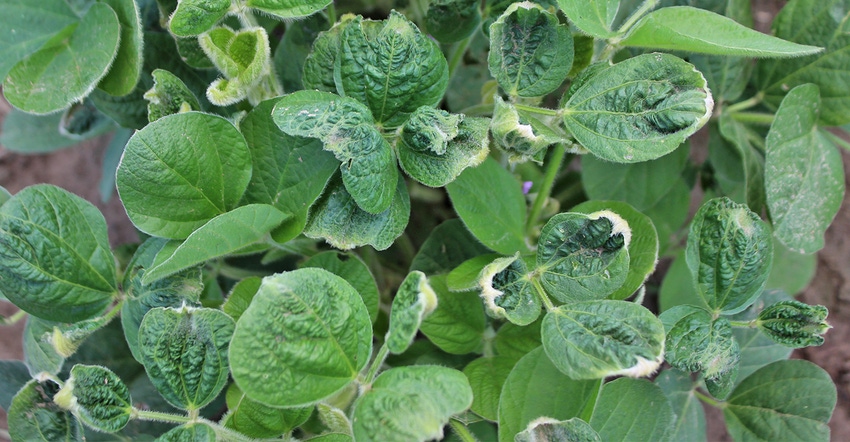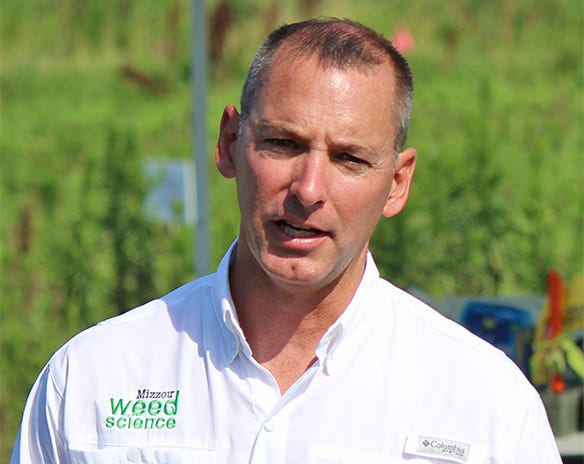
Love it or hate it, there will be dicamba formulations sprayed on farm fields across the U.S. this year. The murmur in agriculture circles is there will be a repeat of drift damage, and more complaints.
Farmers planted 90 million acres of soybeans this year; of those, 3.6 million acres showed signs of injury linked to dicamba, according to University of Missouri data. Still, Monsanto predicts farmers will double their plantings of Xtend soybeans to about 40 million acres next year.
This means that more of Monsanto’s XtendiMax, BASF’s Engenia and DuPont’s FeXapan, herbicides based on a chemical known as dicamba, will likely be applied. Spray restrictions are in place from a federal and, in many cases, a state level. But will they matter?
“We will see a repeat,” says Mike Arway, Missouri Department of Agriculture pesticide use investigator. The state’s cutoff date of July 15 for spraying dicamba formulations may not be early enough to prevent damage. That is 10 days after the stop sale of 2017. By that time, there were already 134 complaints of dicamba injury reported.
Arway clarified his remarks to a group of farmers, crop consultants and agronomist gathered at the Northwest Missouri Crop Conference as his “personal opinion, based on what he has seen and done over the past year.” He adds that with more dicamba-tolerant seed planted, there is a possibility of fewer complaints, but it is not necessarily the case.

ON RECORD: University of Missouri Extension weed scientist Kevin Bradley traveled the country sharing his concerns over the use of dicamba in crops. He says the spray cutoff dates in Missouri will likely not affect damage complaints this year.

Data backs concern
The Missouri Bootheel region has roughly 300,000 acres of cotton. This is the third year farmers will plant Xtend cotton in the region. According to Kevin Bradley, University of Missouri Extension weed scientist, 80% of the acres are Xtend cotton. “We now have a crop that is in 10 counties, 300,000 acres — 80% sprayed with dicamba at least two times over the top,” he told the group.
He adds there are 875,000 acres of soybeans in that same 10-county area. Last year, regional agronomists reported roughly 60% of those acres planted to Xtend soybeans.
“Now we have 80% cotton and 60% soybeans acres adopting this technology,” Bradley adds. “There is a lot of dicamba being sprayed in a fairly small geographical area. Still, there is a lot of damage. Something is going on with these chemicals.”
He cautions that other regions of Missouri and the Midwest have not reached those trait adoption percentages.
“What will happen when you do?” he asks. If history is any indication — the Bootheel region accounted for two-thirds of Missouri’s total dicamba injury complaints — more dicamba complaints are imminent.
Will restrictions help?
Whether the spray cutoff dates are in enough time to reduce injury on more acres this year is still a sore subject.
Bradley disagrees with the Missouri Department of Agriculture’s recommendation of a June 1 cutoff date in the Bootheel for use of Engenia, XtendiMax and FeXapan in dicamba-tolerant soybeans and cotton, along with a July 15 date for all remaining Missouri counties.
“They went against my recommendation,” he says. “July 15 I don’t think will have any impact whatsoever on post application of dicamba in the state of Missouri. I have a black and white letter to hand off to anybody who starts blaming me next year, because I made it clear to the director and her staff. I don’t think July 15 is really going to impact the situation.”
However, Missouri Director of Agriculture Chris Chinn stands by her decision.
“The decision to put in place additional label restrictions for the 2018 growing season was not taken lightly by the Missouri Department of Agriculture,” Chinn says. “Research and recommendations from universities were considered, along with input from farmers, industry and agriculture and commodity organizations. The Special Local Need labels reflect a compromise — one the department believes will protect farmers and the technology.”
What’s at stake?
“The EPA has been painfully clear they will not label another dicamba product until we figure out what is going on with the current ones,” Bradley says.
In November, the EPA will decide whether farmers are going to have these types of herbicides for their fields in the future. “All you need to do to revoke those herbicides is to have another year like last year, or worse,” he adds.
About the Author(s)
You May Also Like






